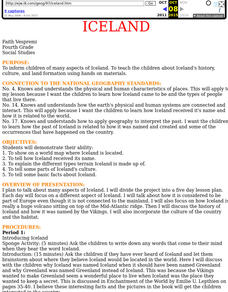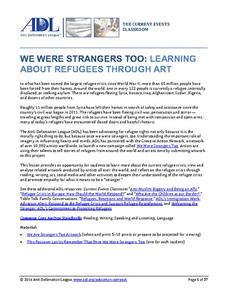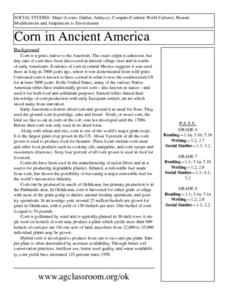Curated OER
Confronting Two Challenges--One Physical, One Intellectual
Students examine the challenges of a new language and culture. In this cultural lesson, student read Running by Peter Hessler and discuss obstacles faced, including the language barrier. Students write an essay about a time they...
Curated OER
The Power of the Image: Understanding Symbols in Buddhist Art
Students discuss symbolism in art, examine various images of compassion in Buddhist tradition, analyzing components of the concept, and then produce their own images of compassion through art.
Alabama Department of Archives and History
Marketing a Bad Idea: Why So Many People Joined the Klan in the 1920s
How did the Klu Klux Klan manage to gain so many members during the 1920s? Class members examine Klan documents and promotional materials to gain an understanding of the propaganda techniques used to attract members.
Curated OER
Japanese Music Study
Gagaku is music traditionally played in the Japanese imperial courts of long ago. Learners listen to this and other traditional Japanese music to gain an understanding of culture and music history. They work to identify Japanese...
Foreign Policy Research Institute
The People's Republic of China
This resource provides a nice framework for young scholars to explore the perceived shift in China's policymaking from the idealogical to the practical. While this lesson includes some dated materials (2006 is the most...
Curated OER
Iceland
Fourth graders discover the country of Iceland. They investigate Iceland's history, culture, and geography using hands-on materials. They engage in a multi-day lesson plan. Each day focuses on a different aspect of Iceland. A...
Curated OER
Landscape Confection: Pre-visit Activity
Upper graders explore the concepts of landscape art, man, nature and their inter-relationship. This is a critical thinking and analysis activity intended to prepare the class for an up coming trip to a local art museum. They analyze,...
Curated OER
Invent It!
Students explore invention and unveiling of world's first Ferris wheel, analyze photographs and poster of first Ferris wheel, and discuss engineering achievements of Ferris wheel, including how it worked, how it was built, and its...
Curated OER
Diaries And Memoirs
Students analyze how personal diaries and memoirs record actual events. They compare and contrast diaries and memoirs from the Holocaust. They engage in journal or diary writing as a way to explore one's own feelings and self.
Curated OER
Soar Into Spring With Kites!
The kite has an amazing history! It has been used for thousands of years, has led to many scientific disoveries, and has made some people very famous. Just ask Ben Franklin! This terrific lesson offers many cross-curricular activities...
Curated OER
American Jews and Civil Rights
Tenth graders examine the Civil Rights movement of the 1960's and how American Jews were involved. They discuss the responsibilities of any minority or ethnic group. They consider the process of change in politics as well.
National Park Service
The Power of Remembrance
On every July 4th, we watch fireworks and celebrate our independence, but how is the history of the American Revolution preserved? Four social studies lesson guide learners through different memorials, commemorative objects, and restored...
City University of New York
Urban Politics: Machines and Reformers
Take a trip to the turn of the twentieth century with a resource about industrialism in America. With primary source documents and focus questions, learners think about the ways that government groups and organizations paved the way...
Museum of Disability
Taking Visual Impairment to School
What is the world like when you can't see, or when your vision is impaired? Learn about how Lisa communicates with the world around her with Taking Visual Impairment to School by Rita Whitman Steingold. Learners answer...
NIOS Download
The Harappan Civilization
The Harappan Civilization, also known as the Indus Valley civilization (2600 BC-1900 BC), is the focus of a resource packet that details the rise and fall of a culture that existed in India during the Chalcolithic period of...
PBS
Myth of the West: Lonely But Free I’ll Be Found
Tumbling tumbleweeds! Scholars work with video clips, primary and secondary documents, and song lyrics to uncover life in the Old West. They examine song's lyrics to uncover myths told in the 1930s about life in the Wild West.
University of California
Principles vs. Practices
Have you ever wondered what your own World Order would look like? Scholars use primary and secondary documents as well as video clips to investigate and analyze the Cold War. Using the sources, the principles and practices of nations...
Museum of Disability
Buddy, The First Seeing Eye Dog
Learn about how the seeing eye dog program began with a reading lesson about Eva Moore's chapter book, Buddy, The First Seeing Eye Dog. With vocabulary words, discussion questions, and extension resources, the lesson is a...
The Alamo
A Lesson in Citizenship
What does it mean to be an American citizen? Lieutenant Colonel Commander William Barret Travis believed that it meant honor to country first—even above one's own life. Middle and high schoolers read his final letters from the Alamo that...
Anti-Defamation League
We Were Strangers Too: Learning About Refugees Through Art
Did you know that "in the largest refugee crisis since World War II, more the 64 million people have been forced from their homes"? The Anti-Defamation League presents an activity that asks class members to examine a series of artworks...
Curated OER
Why Empire? Why War?
Tenth graders examine the purpose of territorial expansion. In this World History lesson, 10th graders analyze various articles on World War II. Students prepare arguments for and against territorial expansion.
Curated OER
The Sunni/Shia Split in Iraq
Students examine the historic Shia-Sunni conflict to assess its present-day status in Iraq and determine how it might play out in postwar Iraq. In this World History lesson plan, students research the factors that contribute to the...
Curated OER
Corn in Ancient America
Students explore the importance of corn to the survival of early civilizations of the Americas. Through research and discussion activities, they read and describe how corn was used as food and currency in early civilizations. They...
Curated OER
Korea's Involvement in World War II Whose Point of View?
Students research different points of view concerning Korea's involvement in World War II.

























